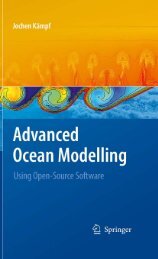Contents
Contents
Contents
- No tags were found...
Create successful ePaper yourself
Turn your PDF publications into a flip-book with our unique Google optimized e-Paper software.
60 3 Basics of Geophysical Fluid DynamicsThis equation implies that the temperature will locally change as long as the temperatureprofil is curved. In other words, the temperature distribution approachesa steady state once the a uniform vertical gradient in temperature is establishedin the flui column. The value of turbulent diffusivity K z determines the time ittakes for this steady state to establish. Obviously, the resultant vertical temperaturegradient depends crucially on heat flu es across boundaries. In the absence of suchheat flu es, the steady-state temperature fiel can only be uniform (well-mixed)throughout the fluid3.16 The Navier–Stokes Equations3.16.1 Complete Set of EquationsThe Navier–Stokes equations (Navier, 1822; Stokes, 1845) comprise a set of coupledconservation equations required to describe motions in fluids These equations consistof the momentum equations, the continuity equation (expressing conservationof volume), advection-diffusion equations for fiel variables such as temperatureand salinity, and the equation of state. The momentum equations can be expressedby:∂u∂t + Adv(u) − f v =−1 ∂ Pρ o ∂x + Diff(u)∂v∂t + Adv(v) + fu=−1 ∂ Pρ o ∂y + Diff(v)∂w+ Adv(w) =− 1 ∂ P∂tρ o ∂z − ρ′g + Diff(w)ρ o(3.63)where (u,v,w) is the velocity vector, t is time, (x, y, z) is the location vector in theCartesian coordinate system, f is the Coriolis parameter, P is dynamic pressure, g ′is reduced gravity, the operator Adv() denotes the nonlinear terms, and Diff() refersto the diffusion terms.The continuity equation in its local form is given by:∂u∂x + ∂v∂y + ∂w∂z = 0 (3.64)For a linear equation of state and the assumption that eddy diffusivities are thesame for temperature and salinity, we can formulate an advection-diffusion equationfor density anomalies, called the density conservation equation, that can beformulated as:∂ρ ′∂t+ Adv(ρ ′ ) = Diff(ρ ′ ) (3.65)
















